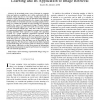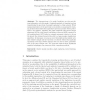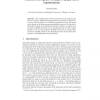430
click to vote
CVPR
2013
IEEE
12 years 7 months ago
2013
IEEE
The graph Laplacian operator, which originated in spectral graph theory, is commonly used for learning applications such as spectral clustering and embedding. In this paper we expl...
139
click to vote
TIP
2010
14 years 11 months ago
2010
—In increasingly many cases of interest in computer vision and pattern recognition, one is often confronted with the situation where data size is very large. Usually, the labels ...
125
click to vote
PKDD
2010
Springer
14 years 11 months ago
2010
Springer
Abstract. The eigenspectrum of a graph Laplacian encodes smoothness information over the graph. A natural approach to learning involves transforming the spectrum of a graph Laplaci...
125
click to vote
PR
2007
15 years 12 days ago
2007
In this paper, we make use of the relationship between the Laplace–Beltrami operator and the graph Laplacian, for the purposes of embedding a graph onto a Riemannian manifold. T...
112
click to vote
TIP
2008
15 years 24 days ago
2008
We introduce a graph Laplacian based algorithm for the tomography reconstruction of a planar object from its projections taken at random unknown directions. The algorithm is shown ...
149
click to vote
CORR
2006
Springer
15 years 28 days ago
2006
Springer
Given a sample from a probability measure with support on a submanifold in Euclidean space one can construct a neighborhood graph which can be seen as an approximation of the subm...
131
click to vote
NIPS
2008
15 years 2 months ago
2008
Semantic hashing[1] seeks compact binary codes of data-points so that the Hamming distance between codewords correlates with semantic similarity. In this paper, we show that the p...
NIPS
2008
15 years 2 months ago
2008
Given an n-vertex weighted tree with structural diameter S and a subset of m vertices, we present a technique to compute a corresponding m
116
click to vote
COLT
2006
Springer
15 years 4 months ago
2006
Springer
Abstract. The regularization functional induced by the graph Laplacian of a random neighborhood graph based on the data is adaptive in two ways. First it adapts to an underlying ma...
127
click to vote
COLT
2004
Springer
15 years 6 months ago
2004
Springer
Given a set of n randomly drawn sample points, spectral clustering in its simplest form uses the second eigenvector of the graph Laplacian matrix, constructed on the similarity gra...



